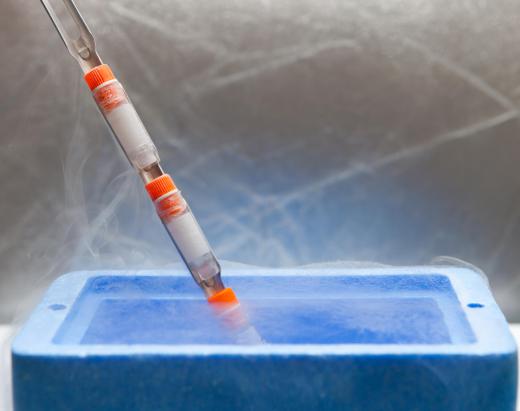Cryogenic grinding is a process used in various manufacturing industries and in the study of biology. Also known as freezer milling or freezer grinding, this method is used to process soft or flexible substances by lowering the material's temperature and then breaking the material into smaller particles. Using this process, substances that are too soft or flexible for grinding at room temperature can be hardened for processing.
This process utilizes liquid nitrogen, liquid argon or liquid carbon dioxide to attain the low temperatures necessary to harden the substances being worked with. These supercooling liquids, which reach temperatures of minus-324.4 degrees Fahrenheit (about minus-198 degrees Celsius) in the case of liquid nitrogen, are capable of freezing most materials on contact. In a controlled environment, the temperature of the material being worked with can be regulated to allow even the softest of materials to be processed using cryogenic grinding equipment.

The equipment used for cryogenic processing and grinding has to be able to handle the extreme temperatures of the process. For this reason, typical cryogenic grinding equipment uses the single moving part design, thus reducing the risks of equipment failure. In this type of equipment, a solenoid is used to move the grinding media inside the vial.
Cryomilling also falls under the heading of cryogenic grinding, although the process and equipment used are slightly different. In this form of cryogenic grinding, the materials are chilled using a slurry of liquid argon or liquid nitrogen to attain the cryogenic temperatures required for the process. Conventional mechanical milling equipment is used for the milling process, however, rather than the single moving part design of typical cryogenic grinding equipment.
The cryogenic grinding processing method is used in various manufacturing industries on a regular basis. Using this method to process thermoplastics and similar substances, manufacturers can create fine powders or particles from these materials. This task would not be possible with conventional grinding equipment because the soft and flexible materials would quickly clog the grinding equipment as the material further softened and adhered to the grinder.
The ability of the supercooling liquids used in this process to harden soft materials makes cryogenic grinding an ideal choice for biologists who wish to study tissue samples from plants and animals. Using the cryogenic grinding process and the low temperatures that are at the core of the operation, biologists can even extract nucleic acids from tissue samples. For this procedure, temperatures of minus-80 degrees Fahrenheit (about 26.6 degrees Celsius) are required throughout the extraction process. This temperature falls well within the range of the cryogenic grinding equipment's normal operating temperature.
